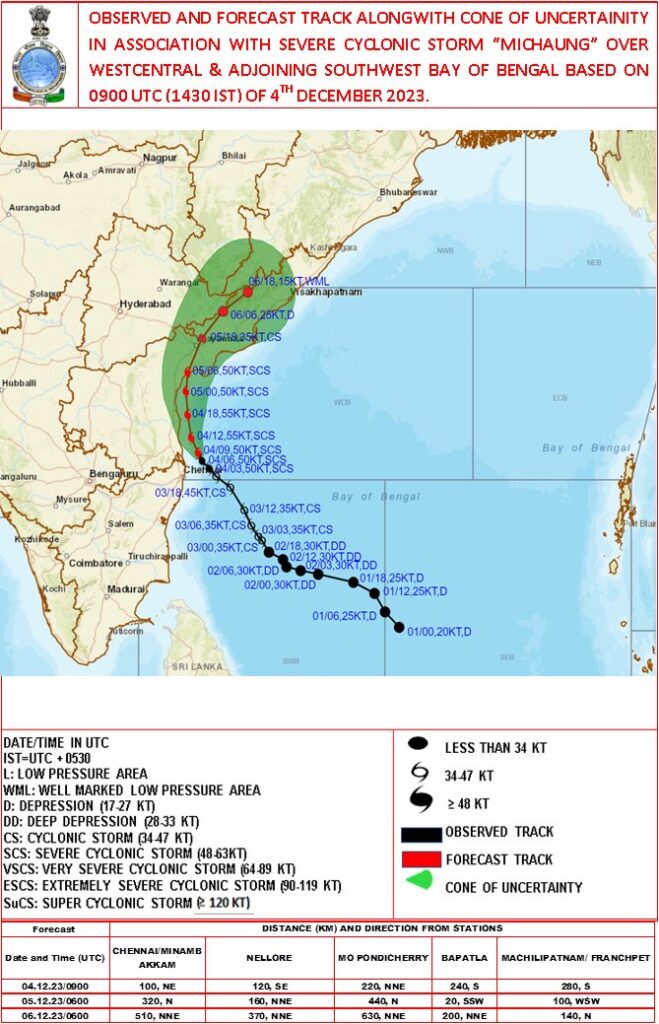As the cyclone season intensifies, the India Meteorological Department (IMD) has issued a cyclone alert, projecting the formation of Cyclone Michaung over the southwest Bay of Bengal. Set to make landfall on December 5 in the coastal districts of Tamil Nadu and Andhra Pradesh, authorities are taking pre-emptive measures to mitigate potential risks associated with this impending weather event.
The recent deluge of heavy rains in Tamil Nadu, particularly in areas like Chennai, Chengalpet, Kancheepuram, and Tiruvallur districts, has already caused havoc. Power cuts, disruptions in transportation, and flight cancellations underscore the immediate challenges posed by the relentless rainfall, emphasizing the urgency of preparations for the approaching cyclone.
Cyclone Michaung: Origin and Naming
Cyclone Michaung, the fourth tropical cyclone in the Bay of Bengal and the sixth in the broader Indian Ocean this year, has garnered attention. Named by Myanmar, it is expected to reach a maximum wind speed of 60-70 kmph, with gusts potentially reaching 80 kmph.
The IMD’s global forecasting system outlines a trajectory for Cyclone Michaung, projecting it to intensify into a cyclonic storm over the southwest Bay of Bengal by November 30. Further strengthening is anticipated as it alters its course to a north-northwest direction, with a potential landfall along the beaches of South and North Odisha on December 5, presenting itself as a formidable and very strong cyclonic storm.
Impact and Alert in Coastal Regions
The Andaman Islands are expected to experience light to moderate rainfall on November 30, accompanied by sporadic areas of extremely heavy rainfall. Regardless of the precise movement, rough sea conditions and gusty winds in the Bay of Bengal are anticipated. Fisherfolk have received strict advisories against venturing into these turbulent waters in the coming days.
In anticipation of Cyclone Michaung, coastal areas, including Tamil Nadu, coastal Andhra Pradesh, and Odisha, are predicted to be in the yellow zone on December 2. This signals rough sea conditions and gusty winds, prompting heightened safety measures. The Odisha government has placed seven districts on high alert, including Balasore, Bhadrak, Kendrapara, Jagatsinghpur, Puri, Khurda, and Ganjam.

Safety Measures and Precautions
As part of safety measures, fisherfolk are strongly advised to refrain from venturing into the waters in the coming days. Authorities are actively disseminating information to the public to ensure preparedness and mitigate potential risks associated with the cyclone’s impact.
Cyclone Michaung’s Development Timeline
The development timeline of Cyclone Michaung unfolds as it is expected to transform into a depression by November 29, progressing to intensify further and move north-westward and northward. Landfall, estimated to occur on December 4 or 5, underscores the urgency of ongoing monitoring and preparedness efforts.
Understanding Cyclones: A Brief Overview
A brief overview is provided regarding the nature of cyclones, characterized as large-scale systems of air rotating around the centre of a low-pressure area. The NDMA’s classification of cyclones into extratropical and tropical categories is highlighted, setting the stage for a deeper understanding of the imminent threat.
Extratropical Cyclones vs. Tropical Cyclones
Distinguishing between extratropical and tropical cyclones, the former occurring outside the tropics and deriving energy from the interaction of cold and warm air masses, and the latter developing within the Tropics of Capricorn and Cancer, drawing energy primarily from warm ocean waters. The importance of recognizing the associated fronts in extratropical cyclones is emphasized.
Tropical cyclones, depending on their location and intensity, assume different names such as hurricanes, typhoons, or cyclones. The geographical variations in nomenclature provide a broader context for understanding the global impact of these weather phenomena.
